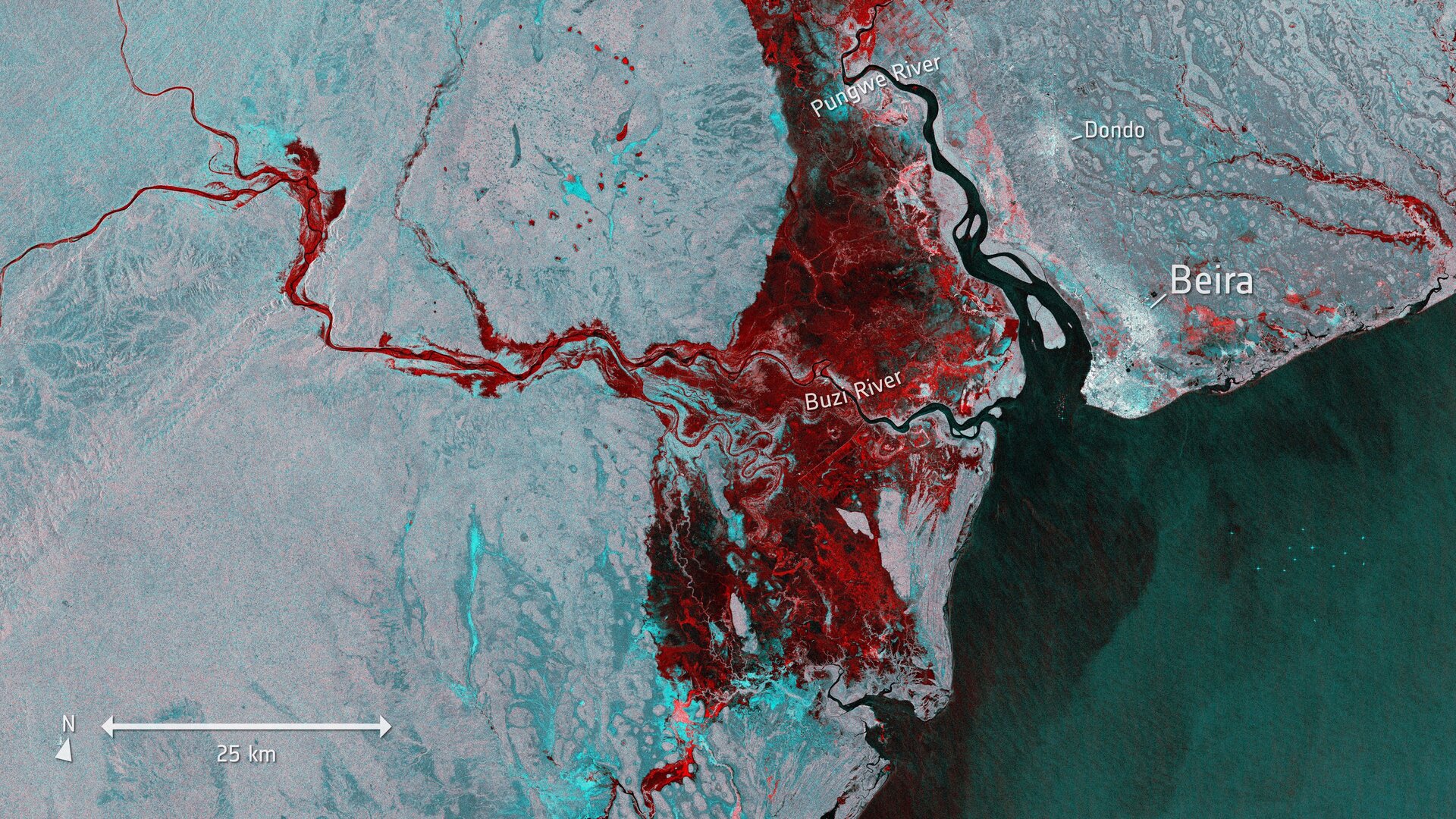SAR-Change service specifications
![]()
This service provides a Red-Cyan composite based on backscatter values in dB using a pair of Sigma Nought assets at same polarization from SAR Calibrated datasets acquired by the same sensor. It also provides co-located single band assets of the pre- and post-event Sigma0 in dB.
The tutorial of the SAR-Change service is available in this section.
Service Description
The SAR Amplitude Change (SAR-Change) service provides an RGB composite of backscattering from a pair of SAR amplitude images (e.g. pre- and post-event).
This Red-Cyan backscatter composite is useful to visually detect changes in backscatter coefficient (e.g. in a flood scenario). Areas in Red indicate a decrease in backscattering on those areas where new flooded areas occur, dark areas depict regions where the water is standing both dates, while cyan regions are those where water is receding.
Figure 1 - An example of RGB color composite which highlights the change in radar backscattering from a pair of SAR detected images, acquired from Sentinel-1 on 2 and 20 March 2019, during the flood event that occurred in lower Shire River between Malawi and Mozambique (Image credits ESA. This image contains modified Copernicus Sentinel data (2019), processed by ESA)1.
It also provides backscatter coefficient in dB for the two input images. The SAR Amplitude Change processor inherits its methodology from the SNAC service of the GEP2.
Warning
The pre-event and post-event must be SAR calibrated dataset. Such image pairs must come from the same sensor.
Note
For reasons of consistency in the visual inspection of changes, the selected pair of SAR images shall have, when possible, pre- and post-event images acquired under the same radar geometry (incident angle, orbit path).
Workflow
The processing service applies the workflow below:
This is done for each polarization available in the acquisitions. The range applied above depends on the mission SAR band and polarization. The below Table 1 reports the values used:
| Polarization | L | C | X |
|---|---|---|---|
| VV | [-27,0] | [-20,0] | [-22,2] |
| HH | [-27,0] | [-20,0] | [-22,2] |
| VH | [-35,-5] | [-26,-5] | [-27,-3] |
| HV | [-35,-5] | [-26,-5] | [-27,-3] |
Table 1 - Valid range in dB adopted for subsetting sigma nought.
Inputs
Input of the SAR Amplitude Change service are at least two SAR Detected amplitude images. In particular, it uses as input calibrated products from the systematic Radar products Calibration. Service inputs are listed and described below.
Parameters
The SAR-change service requires a specified number of mandatory and optional parameters. All service parameters are listed in the below Table 2.
| Parameter | Description | Required | Default value |
|---|---|---|---|
| Pre-event SAR calibrated dataset | Sigma0 in db from pre-event SAR data | YES | |
| Post-event SAR calibrated dataset | Sigma0 in db from post-event SAR data | YES | |
| Area of Interest | Area of interest expressed in WKT | NO |
Table 2 - Service parameters for the SAR-change processor.
Pre- and post-event SAR calibrated datasets
The pre-event and post-event are SAR calibrated datasets, must come from the same sensor and shall have the same radar geometry (incident angle, orbit path).
AOI (optional)
This last parameter (optional) may define the area of interest expressed as a Well-Known Text value. If set, it overrides the automatic determination of the maximium common area between the input-reference products geometry.
Outputs
The SAR-change processor provides as output the following products in GeoTIFF format:
- Product A: RGB composite: Red=(Sigma0 post-), Green=(Sigma0 pre-) , Blue=(Sigma0 pre-)
- Product B: Pre-event sigma nought product [db]
- Product C: Post-event sigma nought product [db].
SAR-Change Product Specifications can be found in the below tables.
| Attribute | Value / description |
|---|---|
| Long Name | SAR Amplitude Change RGB composite |
| Short Name | overview-PP (where PP is the polarization [HH, HV, VH, VV]) |
| Description | Red-Cyan RGBA Composite (R=Sigma0 from post-, G=Sigma0 from pre-, B=Sigma0 from pre-) including transparency |
| Processing level | L1 |
| Data Type | UnSigned 8-bit Integer |
| Band | 4 |
| Format | COG |
| Projection | Native or EPSG:4326 - WGS84 |
| Valid Range | [1 - 255] |
| Fill Value | 0 |
| Attribute | Value / description |
|---|---|
| Long Name | Backscatter coefficient from pre-event SAR calibrated data |
| Short Name | 1.s0_db_B_PP (where PP is the polarization [HH, HV, VH, VV] and B the SAR-band [X,C,L)] |
| Description | Backscatter gray scale single band image of pre-event product |
| Processing level | L1 |
| Data Type | Float 32 bit |
| Band | Single for each polarization |
| Format | COG |
| Projection | Native or EPSG:4326 - WGS84 |
| Units | dB |
| Attribute | Value / description |
|---|---|
| Long Name | Backscatter coefficient from post-event SAR calibrated data |
| Short Name | 2.s0_db_B_PP (where PP is the polarization [HH, HV, VH, VV] and B the SAR-band [X,C,L)] |
| Description | Backscatter gray scale single band image of post-event product |
| Processing level | L1 |
| Data Type | Float 32 bit |
| Band | Single for each polarization |
| Format | COG |
| Projection | Native or EPSG:4326 - WGS84 |
| Units | dB |
-
ESA Observing the Earth, Flooding following Cyclone Idai, available at ESA Multimedia. ↩
-
Terradue, SNAC service tutorial, available at https://docs.terradue.com. ↩
